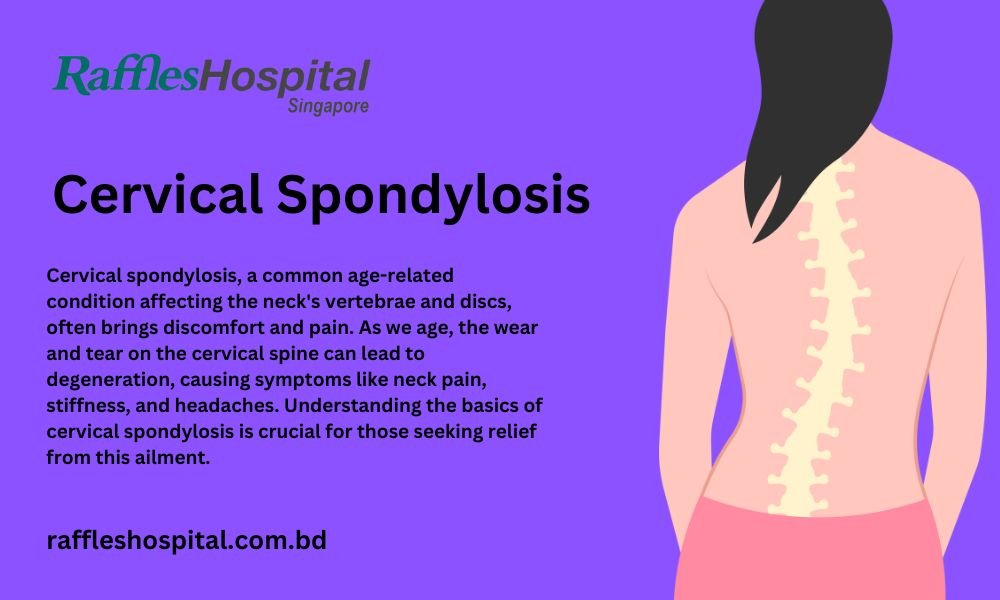Cervical spondylosis, a common age-related condition affecting the neck’s vertebrae and discs, often brings discomfort and pain. As we age, the wear and tear on the cervical spine can lead to degeneration, causing symptoms like neck pain, stiffness, and headaches. Understanding the basics of cervical spondylosis is crucial for those seeking relief from this ailment.
Exploring the Causes of Cervical Spondylosis
Several factors contribute to the development of cervical spondylosis. Everyday wear on the spine, coupled with genetic predispositions, can accelerate the degenerative process. Poor posture, prolonged sitting, and a sedentary lifestyle also play significant roles. Understanding these causative factors empowers individuals to make proactive lifestyle changes that can mitigate the impact of cervical’s spondylosis.
Symptoms Decoded: Recognizing Cervical Spondylosis
Recognizing the symptoms of cervical spondylosis is the first step toward effective management. Persistent neck pain, stiffness, and headaches are common indicators. Additionally, some individuals may experience tingling or weakness in the arms and hands. Familiarizing oneself with these symptoms enables early intervention, preventing further progression of the condition.

Cervical Spondylosis
Taking Charge: Lifestyle Modifications for Cervical Spondylosis
Simple lifestyle modifications can make a substantial difference in managing cervical spondylosis. Regular neck exercises, maintaining proper posture, and staying active can enhance neck muscle strength and flexibility. Incorporating these habits into daily life not only alleviates discomfort but also contributes to overall well-being.
Exercise Essentials: Strengthening the Neck
Engaging in targeted neck exercises is a key component of managing cervical’s spondylosis. Gentle stretches, neck tilts, and rotations can improve flexibility and reduce stiffness. These exercises, when performed consistently, contribute to the strengthening of neck muscles, promoting better support for the cervical spine.
Ergonomics Matters: Creating a Neck-Friendly Environment
Creating an ergonomic environment is essential for individuals dealing with cervical’s spondylosis. Simple adjustments, such as using a supportive pillow, maintaining an eye-level computer monitor, and avoiding prolonged periods of looking down at devices, can significantly reduce strain on the neck. Implementing these changes in daily activities fosters a neck-friendly lifestyle.
Professional Guidance: Consulting with Healthcare Experts
Seeking professional guidance is crucial for effective management of cervical’s spondylosis. Healthcare experts, including physiotherapists and orthopedic specialists, can provide personalized advice and therapeutic interventions. Collaborating with these professionals ensures a comprehensive approach to tackling cervical spondylosis.

Cervical Spondylosis
Pain Management: Exploring Non-Surgical Options
For individuals experiencing persistent pain, exploring non-surgical options for pain management is essential. Physical therapy, medications, and corticosteroid injections are common interventions that can provide relief. Understanding these options and their potential benefits empowers individuals to make informed decisions about their treatment plan.
Surgical Considerations: When Is Surgery Necessary?
In some cases, surgical intervention may be necessary for advanced cervical spondylosis. Decompressive procedures, such as discectomy or cervical fusion, aim to alleviate pressure on the affected nerves. While surgery is typically considered a last resort, understanding the circumstances that warrant surgical intervention is crucial for individuals facing severe and debilitating symptoms.
Looking Ahead: Proactive Measures for Long-Term Neck Health
Taking proactive measures for long-term neck health is essential, even after managing cervical spondylosis symptoms. Continuing to practice good posture, staying physically active, and incorporating neck exercises into daily routines contribute to ongoing neck strength and resilience. By adopting these habits, individuals can minimize the risk of recurrence and maintain a healthy neck throughout their lives.
In Conclusion: A Roadmap to Neck Wellness
In the journey to overcome cervical spondylosis, understanding the condition, recognizing symptoms, and embracing proactive lifestyle changes are paramount. By incorporating exercise, optimizing ergonomics, seeking professional guidance, and exploring appropriate interventions, individuals can pave the way for a life free from the constraints of neck pain. Remember, a neck-friendly lifestyle is within reach, and with determination and consistency, defeating cervical spondylosis is an achievable goal.
1. What is cervical spondylosis, and how does it affect the neck?
Cervical spondylosis is an age-related condition that affects the neck’s vertebrae and discs, leading to degeneration and symptoms such as neck pain, stiffness, and headaches.
2. What causes, and can it be prevented?
Various factors contribute, including everyday wear on the spine, genetic predispositions, poor posture, prolonged sitting, and a sedentary lifestyle. While it may not be entirely preventable, proactive lifestyle changes can mitigate its impact.
3. What are the common symptoms?
Common symptoms include persistent neck pain, stiffness, headaches, and, in some cases, tingling or weakness in the arms and hands.
4. How can lifestyle modifications help manage?
Simple modifications such as regular neck exercises, maintaining proper posture, and staying active can alleviate discomfort and contribute to overall well-being.
5. What are some essential neck exercises to strengthen muscles and reduce stiffness?
Gentle stretches, neck tilts, and rotations are key exercises that, when performed consistently, can strengthen neck muscles and promote flexibility.
6. Why is creating an ergonomic environment important for those with cervical spondylosis?
An ergonomic environment, including the use of supportive pillows and maintaining eye-level computer monitors, can significantly reduce strain on the neck and contribute to a neck-friendly lifestyle.
7. When should individuals seek professional guidance?
Professional guidance from healthcare experts, such as physiotherapists and orthopedic specialists, is crucial for personalized advice and therapeutic interventions, ensuring a comprehensive approach to management.
8. What non-surgical options are available for pain management?
Physical therapy, medications, and corticosteroid injections are common non-surgical interventions that can provide relief from persistent pain.
9. When is surgery considered for cervical spondylosis, and what procedures are involved?
Surgery is typically a last resort for advanced cases. Decompressive procedures like discectomy or cervical fusion aim to alleviate pressure on affected nerves.
10. How can individuals ensure long-term neck health after managing cervical spondylosis symptoms?
– Continuing to practice good posture, staying physically active, and incorporating neck exercises into daily routines contribute to ongoing neck strength and resilience, minimizing the risk of recurrence.
11. What is the overall roadmap to neck wellness for individuals dealing?– The journey involves understanding the condition, recognizing symptoms, embracing lifestyle changes, incorporating exercise, optimizing ergonomics, seeking professional guidance, exploring interventions, and adopting proactive measures for long-term neck health

